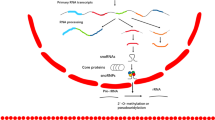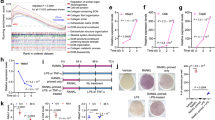Abstract
We have previously shown that miR-486-5p is one of the most downregulated micro RNAs in lung cancer. The objective of the study was to investigate the role of miR-486-5p in the progression and metastasis of non-small-cell lung cancer (NSCLC). We evaluated miR-486-5p expression status on 76 frozen and 33 formalin-fixed paraffin-embedded tissues of NSCLC by quantitative reverse transcriptase PCR to determine its clinicopathologic significance. We then performed function analysis of miR-486-5p to determine its potential roles on cancer cell migration and invasion in vitro and metastasis in vivo. We also investigated the target genes of miR-486-5p in lung tumorigenesis. miR-486-5p expression level was significantly lower in lung tumors compared with their corresponding normal tissues (P<0.0001), and associated with stage (P=0.0001) and lymph node metastasis of NSCLC (P=0.0019). Forced expression of miR-486-5p inhibited NSCLC cell migration and invasion in vitro and metastasis in mice by inhibiting cell proliferation. Furthermore, ectopic expression of miR-486-5p in cancer cells reduced ARHGAP5 expression level, whereas miR-486-5p silencing increased its expression. Luciferase assay demonstrated that miR-486-5p could directly bind to the 3′-untranslated region of ARHGAP5. The expression level of miR-486-5p was inversely correlated with that of ARHGAP5 in lung tumor tissues (P=0.0156). Reduced expression of ARHGAP5 considerably inhibited lung cancer cell migration and invasion, resembling that of miR-486-5p overexpression. miR-486-5p may act as a tumor-suppressor contributing to the progression and metastasis of NSCLC by targeting ARHGAP5. miR-486-5p would provide potential diagnostic and therapeutic targets for the disease.
This is a preview of subscription content, access via your institution
Access options
Subscribe to this journal
Receive 50 print issues and online access
$259.00 per year
only $5.18 per issue
Buy this article
- Purchase on Springer Link
- Instant access to full article PDF
Prices may be subject to local taxes which are calculated during checkout







Similar content being viewed by others
References
Tarver T . Cancer facts & figures 2012. American Cancer Society (ACS). J Consumer Health Internet 2012; 16: 366–367.
Ambros V . MicroRNA pathways in flies and worms: growth, death, fat, stress, and timing. Cell 2003; 113: 673–676.
Yu L, Todd NW, Xing L, Xie Y, Zhang H, Liu Z et al. Early detection of lung adenocarcinoma in sputum by a panel of microRNA markers. Int J Cancer 2010; 127: 2870–2878.
Xing L, Todd NW, Yu L, Fang H, Jiang F . Early detection of squamous cell lung cancer in sputum by a panel of microRNA markers. Mod Pathol 2010; 23: 1157–1164.
Shen J, Liu Z, Todd NW, Zhang H, Liao J, Yu L et al. Diagnosis of lung cancer in individuals with solitary pulmonary nodules by plasma microRNA biomarkers. BMC Cancer 2011; 11: 374.
Xiao C, Rajewsky K . MicroRNA control in the immune system: basic principles. Cell 2009; 136: 26–36.
Saito Y, Jones PA . Epigenetic activation of tumor suppressor microRNAs in human cancer cells. Cell Cycle 2006; 5: 2220–2222.
Lu J, Getz G, Miska EA, Alvarez-Saavedra E, Lamb J, Peck D et al. MicroRNA expression profiles classify human cancers. Nature 2005; 435: 834–838.
Kent OA, Mendell JT . A small piece in the cancer puzzle: microRNAs as tumor suppressors and oncogenes. Oncogene 2006; 25: 6188–6196.
Jenkins DE, Oei Y, Hornig YS, Yu SF, Dusich J, Purchio T et al. Bioluminescent imaging (BLI) to improve and refine traditional murine models of tumor growth and metastasis. Clin Exp Metastasis 2003; 20: 733–744.
Chakravarty G, Hadsell D, Buitrago W, Settleman J, Rosen JM . p190-B RhoGAP regulates mammary ductal morphogenesis. Mol Endocrinol 2003; 17: 1054–1065.
Gen Y, Yasui K, Zen K, Nakajima T, Tsuji K, Endo M et al. A novel amplification target, ARHGAP5, promotes cell spreading and migration by negatively regulating RhoA in Huh-7 hepatocellular carcinoma cells. Cancer Lett 2009; 275: 27–34.
Tan X, Qin W, Zhang L, Hang J, Li B, Zhang C et al. A 5-microRNA signature for lung squamous cell carcinoma diagnosis and hsa-miR-31 for prognosis. Clin Cancer Res 2011; 17: 6802–6811.
Bansal A, Lee IH, Hong X, Anand V, Mathur SC, Gaddam S et al. Feasibility of mcroRNAs as biomarkers for Barrett’s Esophagus progression: a pilot cross-sectional, phase 2 biomarker study. Am J Gastroenterol 2011; 106: 1055–1063.
Ragusa M, Majorana A, Statello L, Maugeri M, Salito L, Barbagallo D et al. Specific alterations of microRNA transcriptome and global network structure in colorectal carcinoma after cetuximab treatment. Mol Cancer Ther 2010; 9: 3396–3409.
Oh HK, Tan AL, Das K, Ooi CH, Deng NT, Tan IB et al. Genomic loss of miR-486 regulates tumor progression and the OLFM4 antiapoptotic factor in gastric cancer. Clin Cancer Res 2011; 17: 2657–2667.
Midorikawa Y, Yamamoto S, Tsuji S, Kamimura N, Ishikawa S, Igarashi H et al. Allelic imbalances and homozygous deletion on 8p23.2 for stepwise progression of hepatocarcinogenesis. Hepatology 2009; 49: 513–522.
Jiang F, Yin Z, Caraway NP, Li R, Katz RL . Genomic profiles in stage I primary non small cell lung cancer using comparative genomic hybridization analysis of cDNA microarrays. Neoplasia 2004; 6: 623–635.
Lim LP, Lau NC, Garrett-Engele P, Grimson A, Schelter JM, Castle J et al. Microarray analysis shows that some microRNAs downregulate large numbers of target mRNAs. Nature 2005; 433: 769–773.
Small EM, O'Rourke JR, Moresi V, Sutherland LB, McAnally J, Gerard RD et al. Regulation of PI3-kinase/Akt signaling by muscle-enriched microRNA-486. Proc Natl Acad Sci USA 2010; 107: 4218–4223.
Lee JO, Yang H, Georgescu MM, Di Cristofano A, Maehama T, Shi Y et al. Crystal structure of the PTEN tumor suppressor: implications for its phosphoinositide phosphatase activity and membrane association. Cell 1999; 99: 323–334.
Teng DH, Hu R, Lin H, Davis T, Iliev D, Frye C et al. MMAC1/PTEN mutations in primary tumor specimens and tumor cell lines. Cancer Res 1997; 57: 5221–5225.
Steck PA, Pershouse MA, Jasser SA, Yung WK, Lin H, Ligon AH et al. Identification of a candidate tumour suppressor gene, MMAC1, at chromosome 10q23.3 that is mutated in multiple advanced cancers. Nat Genet 1997; 15: 356–362.
Heckman-Stoddard BM, Vargo-Gogola T, McHenry PR, Jiang V, Herrick MP, Hilsenbeck SG et al. Haploinsufficiency for p190B RhoGAP inhibits MMTV-Neu tumor progression. Breast Cancer Res 2009; 11: R61.
Sordella R, Classon M, Hu KQ, Matheson SF, Brouns MR, Fine B et al. Modulation of CREB activity by the Rho GTPase regulates cell and organism size during mouse embryonic development. Dev Cell 2002; 2: 553–565.
McHenry PR, Sears JC, Herrick MP, Chang P, Heckman-Stoddard BM, Rybarczyk M et al. P190B RhoGAP has pro-tumorigenic functions during MMTV-Neu mammary tumorigenesis and metastasis. Breast Cancer Res 2010; 12: R73.
Nakahara H, Mueller SC, Nomizu M, Yamada Y, Yeh Y, Chen WT . Activation of beta1 integrin signaling stimulates tyrosine phosphorylation of p190RhoGAP and membrane-protrusive activities at invadopodia. J Biol Chem 1998; 273: 9–12.
Gao SM, Xing CY, Chen CQ, Lin SS, Dong PH, Yu FJ . miR-15a and miR-16-1 inhibit the proliferation of leukemic cells by down-regulating WT1 protein level. J Exp Clin Cancer Res 2011; 30: 110.
Fan T, Li R, Todd NW, Qiu Q, Fang HB, Wang H et al. Up-regulation of 14-3-3zeta in lung cancer and its implication as prognostic and therapeutic target. Cancer Res 2007; 67: 7901–7906.
Mei YP, Liao JP, Shen J, Yu L, Liu BL, Liu L et al. Small nucleolar RNA 42 acts as an oncogene in lung tumorigenesis. Oncogene 2012; 31: 2794–2804.
Wang H, Zhang Z, Li R, Ang KK, Zhang H, Caraway NP et al. Overexpression of S100A2 protein as a prognostic marker for patients with stage I non small cell lung cancer. Int J Cancer 2005; 116: 285–290.
Gavrieli Y, Sherman Y, Ben-Sasson SA . Identification of programmed cell death in situ via specific labeling of nuclear DNA fragmentation. J Cell Biol 1992; 119: 493–501.
Acknowledgements
This work was supported by Grants 81101482 from the National Natural Science Foundation of China and Grants C2011206001 from the Natural Science Foundation of Hebei province, China (to LX) and American Cancer Society-Research Scholar Grant in Basic, Preclinical, Clinical and Epidemiology Research-115154AF109040, National Cancer Institute (NCI)-R01CA161837-01, an exploratory research grant from the Maryland Stem Cell Research Fund, and VA-Merit grant-I01 CX000512-01 (to FJ).
Author information
Authors and Affiliations
Corresponding authors
Ethics declarations
Competing interests
The authors declare no conflict of interest.
Additional information
Supplementary Information accompanies the paper on the Oncogene website
Supplementary information
Rights and permissions
About this article
Cite this article
Wang, J., Tian, X., Han, R. et al. Downregulation of miR-486-5p contributes to tumor progression and metastasis by targeting protumorigenic ARHGAP5 in lung cancer. Oncogene 33, 1181–1189 (2014). https://doi.org/10.1038/onc.2013.42
Received:
Revised:
Accepted:
Published:
Issue Date:
DOI: https://doi.org/10.1038/onc.2013.42
Keywords
This article is cited by
-
Elevated FBXL6 activates both wild-type KRAS and mutant KRASG12D and drives HCC tumorigenesis via the ERK/mTOR/PRELID2/ROS axis in mice
Military Medical Research (2023)
-
DUSP5P1 promotes gastric cancer metastasis and platinum drug resistance
Oncogenesis (2022)
-
The differential expression of miRNAs between ovarian endometrioma and endometriosis-associated ovarian cancer
Journal of Ovarian Research (2020)
-
Upregulation of ARHGAP30 attenuates pancreatic cancer progression by inactivating the β-catenin pathway
Cancer Cell International (2020)
-
RNA-Seq profiling of deregulated miRs in CLL and their impact on clinical outcome
Blood Cancer Journal (2020)



